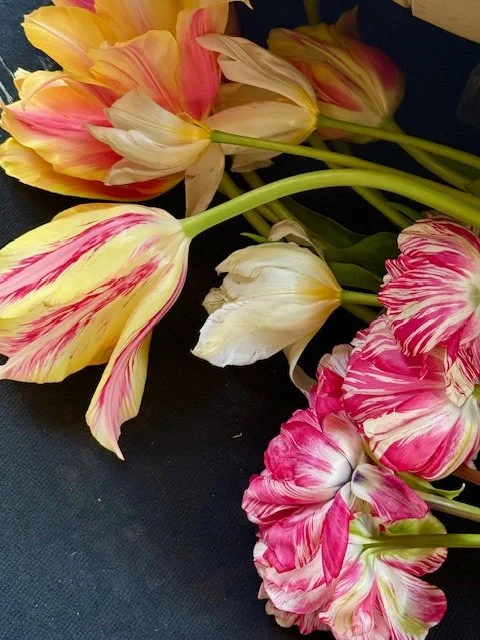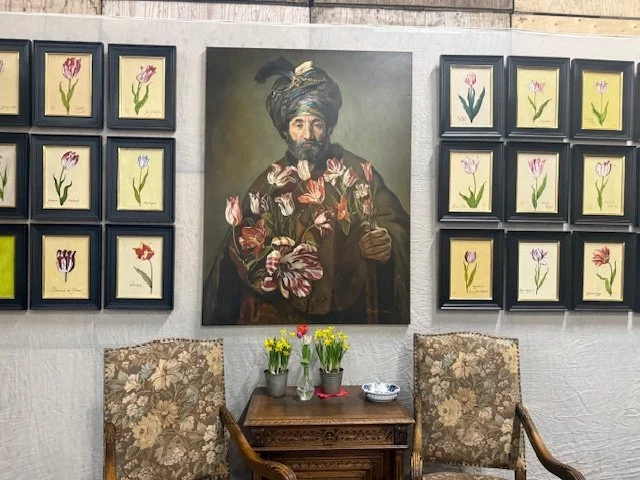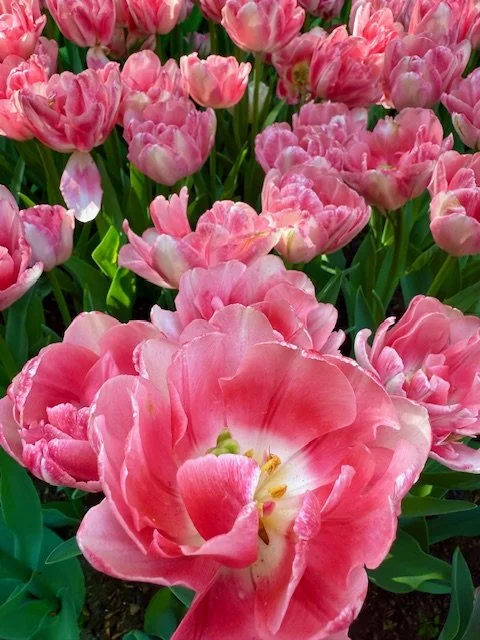Tulip Fever….. Celebrating The Beauty of the Gem of the Netherlands
I am writing to you from a hotel in Amsterdam after the most extraordinary day entirely devoted to the most beautiful of flowers. The tulip. This time of year in Holland is the season of blooming tulips (among other spectacular bulbs), and the Netherlands truly knows how to honor its most beloved and iconic flower.
I learned so much today and am so excited to share the storied history of this flower of great beauty! This is a bloom steeped in deep and ancient fascination and cultivation. From the wind-swept steppes of Kazakhstan, where wild tulips first blossomed in rocky alpine meadows, to the royal gardens of a sultan to the opulent gardens of the Ottoman Empire where they became symbols of paradise, the tulip has traveled an extraordinary path through time. Introduced to the Netherlands in the late 16th century, tulips quickly captured the Dutch imagination, culminating in the infamous Tulip Mania of the 1630s and later becoming a cornerstone of Dutch cultural identity.
Today we visited two of the most quintessential places to celebrate the tulip. At both The Tulip Experience Amsterdam and the world-renowned Keukenhof Gardens, I felt as though I were being initiated into the singular magnificence of one extraordinary bloom. I’ve always been deeply drawn to the kind of devotion that elevates a single flower into a shining star of botanical beauty and variety and wow!!!… I was not disappointed to behold the many way the tulip has been cultivated and celebrated.
I witnessed firsthand how the humble tulip has blossomed into a national treasure and a global ambassador of spring. Today, diverse varietals not only flood the Dutch countryside with breathtaking waves of color, but also grace gardens, festivals, and flower markets around the world each bloom carrying centuries of history, artistry, and cultural meaning.
My little bouquet from The Tulip Experience.
As I wandered through a dreamlike landscape of tulips in every imaginable hue and form, I was in awe…not only of the visual splendor, but also of the reverence with which the Dutch honor this sacred flower. I became increasingly fascinated by the tulip’s rich history and its profound impact on the identity of the Netherlands, a country now inseparable from its most iconic bloom. From the floating flower markets of Amsterdam to the personal stories shared by locals at the Tulip Experience, it became clear that tulips are more than just flowers here. They are living symbols of Dutch heritage, resilience, and a centuries-long love affair that continues to thrive and inspire with every spring.
Striped Parrot tulip at The Tulip Experience. So many amazing varieties. Some even looked like peonies!
The Origins of the Tulip: From the East to the West
The tulip’s origins lay in the mountainous regions of Central Asia, specifically parts of modern day Kazakhstan, Uzbekistan, and Turkey, where the wild ancestors of the modern tulip species, Tulipa gesneriana, can still be found today. These wild varieties were discovered by botanists as early as the 16th century and were highly valued for their striking colors and shapes.
The tulip was first introduced to the West through the Ottoman Empire, where it became a symbol of prosperity and elegance. Sultan Ahmed I's reign (1603–1617) saw the rise of tulips as a prestigious symbol in the empire's gardens. The Ottoman fascination with tulips, along with their use in beautiful and mystical Persian gardens, made the flowers highly coveted in Europe.
The tulip was introduced to the Netherlands through Ogier de Busbecq, the Austrian ambassador to the Ottoman Empire in the 1550s. Busbecq sent several tulip bulbs to Carolus Clusius, a Dutch botanist at Leiden University, where he planted them in the university's botanical gardens. This marked the beginning of tulips' cultivation in Europe, and they quickly became a popular ornamental plant.
Painting of Sultan Ahmed I and Tulips at The Tulip Experience
Tulip Mania: The Rise and Fall of a Flower Fueled Obsession
In the early 17th century, tulips became a powerful symbol of status and wealth in the Netherlands. This cultural shift gave rise to one of the most dramatic economic events in history. Tulip Mania, which spanned from 1634 to 1637. During this period, tulip bulbs were traded at exorbitant prices, sometimes costing more than a house or a skilled worker's annual salary.
At the height of Tulip Mania, rare tulip bulbs, particularly those with unusual patterns or colors, commanded prices that were unimaginable by today's standards. The speculation in tulip bulbs became so extreme that the flower was no longer seen just as a plant but as a highly soughtafter commodity. This speculative frenzy caused prices to soar to unsustainable heights, resulting in the inevitable collapse of the market in February 1637, when tulip prices plummeted, and many investors faced severe financial losses. Historically speaking alot was learned about the very real dangers of speculation in the marketplace.
The Symbolism of Tulips: Love, Passion, and Renewal
Tulips held and still hold rich symbolic meaning in the Netherlands, where they had long been associated with perfect love, beauty, and elegance. The symbolic connection between tulips and love was reflected in Dutch art, where tulips often appeared in still life paintings, often used to symbolize the transient nature of beauty and life itself.
A Still Life of Flowers in a Wan-Li Vase on a Ledge with further Flowers, Shells and a Butterfly
Ambrosius Bosschaert the elder (1573–1621)
In Persian culture, tulips had long been a symbol of paradise and rebirth. The Persian word for tulip, “laleh,” was thought to be derived from the word for "turban," due to the flower’s distinctive shape. Tulips had been central to Persian gardens, which were designed as symbolic representations of paradise. The red tulip, in particular, was seen as a symbol of passionate love and life force.
Additionally, in Turkish culture, tulips were associated with renewal and vitality. During the 16th and 17th centuries, they were featured prominently in Ottoman gardens, and the flower’s design was often said to represent the relationship between humans and the divine. Tulips were considered symbols of heaven and the afterlife, often appearing in artwork to evoke divine beauty.
In modern Western culture, tulips are still frequently used in celebrations of love, such as Valentine’s Day, where red tulips are often associated with passionate affection. The cultural significance of tulips as symbols of new beginnings and love continue to resonate globally.
Medicinal and Culinary Uses of Tulips
Historically, tulips had had limited medicinal or culinary uses, but they were sometimes employed as a food source during times of hardship. Tulip petals, which are mildly sweet in taste, were occasionally used in salads or brewed into teas during periods of scarcity. There are records from the 17th century that suggest tulip bulbs were sometimes used to treat ailments like coughs and respiratory issues.
In the 17th century, when Europe faced food shortages, tulip bulbs were considered a potential substitute for other more commonly used vegetables. However, their nutritional value was low, and this practice was short-lived. Today, tulips are primarily appreciated for their ornamental beauty rather than their culinary or medicinal properties.
Tulips as a Cultural and Economic Legacy
And the world loves tulips indeed. They are celebrated around the world as emblems of beauty, spring, and renewal. In the Netherlands, they remain a national symbol and an essential part of both the landscape and the economy, with vast fields of color drawing millions of visitors each year. In Turkey, where tulips once adorned imperial gardens and inspired poetry during the Ottoman Empire, they are still honored as cultural treasures. Iran, too, reveres the tulip as a national symbol of martyrdom and pride. Across Europe, especially in countries like France, Germany, and the United Kingdom, tulips brighten public parks, private gardens, and bustling flower markets each spring. In Japan, they are admired in curated gardens and seasonal festivals that celebrate their delicate symmetry. The United States is also home to a deep affection for tulips, with beloved traditions like the Tulip Time Festival in Holland, Michigan, and the sweeping floral displays in Washington’s Skagit Valley drawing thousands of visitors annually. Though rooted in Central Asia and cultivated to fame in the Netherlands, the tulip has become a truly global flower beloved across continents for its beauty, elegance, color, and enduring charm.
Keukenhof Gardens, where I had immersed myself in the sights and smells of tulips was awesome and very crowded : ) but you got see first hand this deep rooted relationship between the Dutch people and their beloved flower. Each spring, millions of visitors flock to Keukenhof to witness the dazzling tulip displays that showcase the beauty and diversity of this beloved bloom and others (I saw very cool fritallaria!! ). The gardens were once used for royal hunting, and now house more than 7 million flowers in bloom at any given time. From the classic red and yellow varieties to the intricate frilled and parrot tulips, the gardens celebrate the tulip’s rich history and its continuing legacy in Dutch culture.
Now tired and deeply satisfied as I watch the sun set over the canals of Amsterdam, my heart feels as full and as bright as the fields of color we wandered through. The Dutch devotion to their flowers and to the tulip in particular is nothing short of inspired. Everywhere I turned, there was joy, artistry, and reverence woven into the petals of countless blooms. I like it here. The people we have met radiate warmth, innovation and pride and their connection to the land and its living beauty shines. I leave for Italy in a day feeling enchanted and deeply inspired by the tulip’s story. What an extraordinary celebration of this vibrant bloom and what love I have for this flora loving country that knows how to make a flower feel super special. To me that makes spring in Holland feel like pure magic. 🌷 I hope to visit here again soon. Maybe you will visit too?
stunning tulip variety at Keukenhof
Bibliography
1. Dash, Mike. Tulipmania: The Story of the World’s Most Coveted Flower & the Extraordinary Passions It Aroused.
Wikipedia - History of the Tulip
Pamphlet from The Tulip Experience









